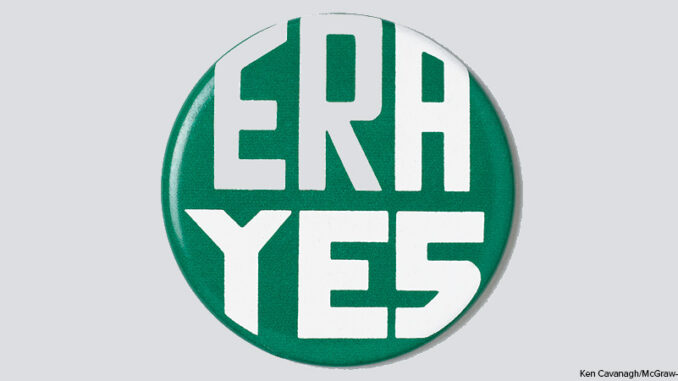
While women’s rights are protected by the 1964 Civil Rights Act, not all of their rights are constitutionally guaranteed. Women in the United States won the right to vote with the 19th Amendment in 1920. Many suffragists recognized the importance of constitutionally protecting equal rights for men and women. In 1923, the Equal Rights Amendment (ERA) was introduced to do just that. In 1943, both the Republican and Democratic parties added support of the ERA to their political platforms. The ERA was continually proposed in Congress until it passed in 1972.
There is a specific process of ratification to get amendments added to the Constitution. Once the Senate and House of Representatives both pass the legislation, the amendment goes to the states for ratification. To be ratified, 38 states, or a three-fourths majority, must approve it. When passed in 1972, Congress placed a seven-year deadline for the ERA ratification process.
The ERA’s Ratification History

In the first year, 22 states ratified. However, as the 1970s unfolded, the pace of ratification slowed and some groups organized in opposition to the amendment. Anti-ERA organizers worried it would
- deny women’s right to be supported by their husbands,
- lead to women being drafted for war, and
- guarantee the upholding of abortion rights and gay marriage.
Pro-ERA advocates, led by the National Organization for Women (NOW) and ERAmerica, worked hard. By 1977 they had 35 states ratified. As the 1979 deadline approached, ERA advocates appealed to Congress for an extension.
In July of 1978 more than 100,000 supporters of the ERA marched in Washington, D.C., and Congress granted an extension until 1982. However, this extension did not bring ratification. In fact, in 1980, there was enough anti-ERA pressure that the Republican Party removed the ERA from its platform. The ERA did not succeed at getting three more states to ratify the amendment. Immediately after defeat, the ERA was reintroduced in Congress, and just like before, it has been introduced in every session since.
A Path Forward?
After Hillary Clinton’s election defeat in 2016 and the Women’s March of 2017 there was renewed interest in the Equal Rights Amendment. Supporters of this century-long initiative still hope to make discrimination on the basis of sex unconstitutional and guarantee equality for women under the Constitution. They believe this amendment would allow better access to childcare, help prevent workplace discrimination due to pregnancy, and help close the pay gap between men and women.
Currently, there are multiple paths forward to achieve amendment status. The first path is known as the three-state strategy. This strategy calls for the removal of the time limit on the ERA’s ratification. This path recently became possible in March 2017 when Nevada became the 36th state to ratify. Soon after, Illinois became the 37th. In January 2020, Virginia became the all-important 38th state to ratify the ERA. Now that three-fourths of states have ratified, pressure has mounted for Congress to remove the 1982 deadline. Legal scholars have argued that since the deadline was created by Congress and not stated in the Constitution, it can also be legislated away. When the 117th U.S. Congress convened on January 21, 2021, similar bills with widespread bipartisan support were introduced to remove the time limit.
The second path is to start over. Some legal scholars argue that this is the safest way to ensure ratification. This process calls for the Senate and the House of Representatives to pass new ERA legislation and re-send it for ratification in all states. Congress is also actively pursuing this path. In 2019 a new amendment concerning equal rights for men and women was introduced as a joint resolution in the Senate and in the House of Representatives.
On Friday, March 5, 2021, three-state strategy supporters were put on the defensive when a federal district judge dismissed a lawsuit by three state attorneys general. The judge stated that the deadline to ratify had expired long ago, making the three recent ratifications invalid. However, the court was not weighing in on whether Congress can move the deadline. In light of this, Virginia’s Attorney General has asked for support from the Biden Administration and Congress to pass the ERA. The House of Representatives is set to vote on the three-state strategy’s joint resolution the week of March 15, 2021, where it is expected to pass. Then, it will head to the Senate where it is projected to face more opposition. After almost 100 years, and many tries, will the Equal Rights Amendment finally be realized?
